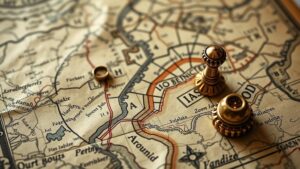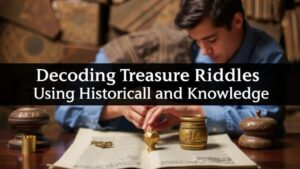Using Associative Thinking to Link Treasure Riddles With Historical Events
Using Associative Thinking to Link Treasure Riddles With Historical Events
Associative thinking is a cognitive process that involves connecting seemingly unrelated ideas or concepts, allowing for creative problem-solving and innovative insights. When applied to treasure riddles, this form of thinking can unlock fascinating links to historical events, enriching our understanding of both the riddles themselves and the contexts from which they emerged. In this article, we will explore how associative thinking can be used to connect treasure riddles with significant historical milestones, providing examples and case studies to illustrate these connections.
Understanding Treasure Riddles
Treasure riddles are often poetic clues that lead to hidden treasures or significant historical artifacts. can be found in literature, folklore, and even modern treasure hunts. The nature of these riddles often captures the imagination, urging readers or participants to engage in a deeper investigation of history and culture. One classic example is Robert Louis Stevenson’s Treasure Island, which features not only tangible treasure but also a wealth of historical references to piracy and exploration in the 18th century.
Historical Events as Context for Riddles
Historical events provide a backdrop against which treasure riddles can be interpreted. For example, during the Gold Rush in the United States in the mid-1800s, many treasure riddles emerged as part of the folklore surrounding the search for gold. These riddles were often steeped in the sociopolitical climate of the time, highlighting themes of greed, exploration, and adventure.
- The discovery of gold in California in 1848 sparked a massive influx of fortune seekers, creating a rapid transformation in demographics and culture.
- Subsequent treasure riddles, such as those connected to the Lost Dutchmans Gold Mine, became synonymous with the myths surrounding the Gold Rush era.
Associative Thinking: Drawing Connections
By employing associative thinking, one can draw compelling connections between riddles and historical events. This method can help us contextualize not only the riddle itself but also its cultural significance in a given era. For example, consider the riddle At dawn, I rise like the sun, but its golden rays are what I seek. This line can lead us to explore the age-old quest for riches throughout history.
Case Study: The Cursed Treasure of Oak Island
The mystery of Oak Island off the coast of Nova Scotia is rich with historical significance and complex riddles. Theories surrounding the “money pit” have included connections to the Lost Templar Treasure and the rumored buried pirate booty of Captain Kidd. By linking these clues with prominent historical events–such as the rise of piracy in the 17th century or the Templar Knights’ expedition–it becomes evident how treasure riddles both reflect and influence the narratives of history.
- The treasure hunters associations with past pirates highlight the cultural fascination with the lawless era of the Golden Age of Piracy.
- Many riddles serve as allegories for the trials and tribulations faced by those who sought unimaginable wealth during tumultuous times in history.
Real-World Applications of Associative Thinking
Useing associative thinking in the academic field can lead to new disciplines emerging, such as the study of cultural treasure riddles and their historical contexts. Educators and historians can use these connections to develop engaging learning experiences. For example:
- Teachers can present riddles linked to historical timelines, prompting students to explore the era or figures associated with each riddle.
- Museums might incorporate interactive exhibits where visitors solve historical riddles to learn about significant artifacts or events.
Conclusion: The Value of Associative Thinking
To wrap up, using associative thinking to connect treasure riddles with historical events opens rich avenues for exploration and understanding. By framing riddles within their historical contexts, one can derive deeper meanings and appreciate the cultural narratives enveloping these enigmatic clues. As we unravel the threads linking these riddles to critical moments in history, we not only solve puzzles but also enrich our knowledge of the human experience across time. Embracing this technique can lead to innovative educational practices and deeper cultural insights, helping us appreciate the complexities of our past as we engage with the treasures it holds.

